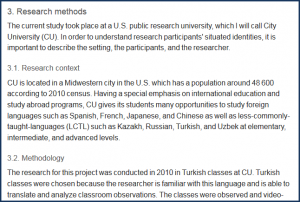At first blush, it seemed like a very simple, clearly written assignment for a student — go and find a case study related to your search topic…to be used in an oral presentation and a written paper.
 The first thing to understand is what the assignment is asking the student to do. It’s asking for a relevant case study applicable to a topic the student identifies for a presentation and then a paper. So let’s break it down into the parts that are critical for the student to get started:
The first thing to understand is what the assignment is asking the student to do. It’s asking for a relevant case study applicable to a topic the student identifies for a presentation and then a paper. So let’s break it down into the parts that are critical for the student to get started:
- Define the search topic
- Find a case study on the topic
- Find other articles (not case studies) related to the topic
- Write an outline for a presentation
- Give the presentation to the class
- Convert this outline into a paper
The student had worked with a librarian previously and had come up with a great search topic, but was now having problems finding a case study related to it. Why? Partly because the term “case study” differs depending on the discipline and the setting as well, but also from finding too many search results and trying to wade through them to find the relevant case study became super difficult. Imagine looking for one case study in over 100,000 possible search results!
 So the next step was to define what case study as the first way to put some additional parameters on the search. According to the OED, a case study refers to:
So the next step was to define what case study as the first way to put some additional parameters on the search. According to the OED, a case study refers to:
- A process or record of research in which detailed consideration is given to the development of a particular person, group, or situation over a period of time.
- A particular instance of something used or analyzed in order to illustrate a thesis or principle.
Besides case studies, there are types of articles called case reviews and case report…which are different, but sometimes used interchangeably by researchers….so if you’re scratching your head right now, let’s set aside the other type of terms and focus in on how just the term case study in a health care setting.
Case studies in health care research, for example, often involve in-depth interviews with participants and key individuals, review of medical records, observations, and experts from patients’ personal writings and diaries. Often library searching is nuanced and complex though, because even though we can define case study by the discipline, undergraduate textbooks tend to defined case study as neither quantitative or qualitative. Depending on the textbook, case studies are often glossed over.
Because the student had chosen a health topic related to clinical applications, we decided to first search in PsycInfo and PubMed. The student had found all kinds of great articles by searching in Google. The problem the student had that day was too many search results…and also, how to know if any of the search results were a case study or not? I am just as guilty as anybody as to searching for answers in Google, but sometimes it really is easier and faster to start in a library database, particularly for a search like this because there are advanced limits for Case Studies.
In PsycInfo for example, if you click into the menu under “methodology” there are two relevant limits for case study, the clinical case study and the nonclinical case study. By understanding the search limits, we could use the clinical case study or nonclinical case study limits to more quickly and effectively narrow down the search results:
- In PsycInfo, a clinical case study is defined by the American Psychological Association as “case reports that include disorder, diagnosis, and clinical treatment for individuals with mental or medical illnesses.”
- Nonclinical case studies refer to “non-clinical or organizational case examples of the concepts being researched or studied. The setting is always non-clinical and does not include treatment-related environment.”
Based on this, can you tell if this citation is a clinical or nonclinical case study:
Uzum, B. (2013). From ‘you’ to ‘we’: A foreign language teacher’s professional journey toward embracing inclusive education. Teaching and Teacher Education, 3369-77.
If you guessed nonclinical, you were right! But if you weren’t sure you can always click into the description of the article and usually the abstract will offer a few more clues about the nature of the article.
At this point, you might be asking, um….I thought this was supposed to be a nonclinical case study, but this article is talking about qualitative research, so what is it? Case study? Qualitative research? Often, case studies use mixed methods, meaning that they can be qualitative or quantitative. After clicking on the article title, you can see more information about the article, including a methodology field, which in this case tells us this particular nonclinical case study is also an empirical study and qualitative study.
The best bet, if you’re still not sure after looking at these extra fields is to read the paper and skim the methodology in the paper itself to see how the author describes it, in the abstract and early on in the paper. Many scientific papers will describe their methodology, so while the format may vary from journal to journal, skim through and look for any section related to methods or methodology, such as:
Case studies require a lot of time, effort, and attention to detail to put together, and yet, some researchers say that they reveal more about a particular subject than any other research method. If you would like more information on how to find case studies in PubMed, let us know and we’ll follow up with another post. So next time you find yourself needing to do some research and getting stuck, remember that librarians are more than happy to help.
In the meantime, these might be of interest:
- Case studies in interdisciplinary research, online book via the JHU Libraries
- Guidelines to writing case studies from PubMed Central (relates to case reports)
- How to do Case Study research by Donna M. Zucker
- What is a Case Study? YouTube video, particularly relevant to psychological case studies



